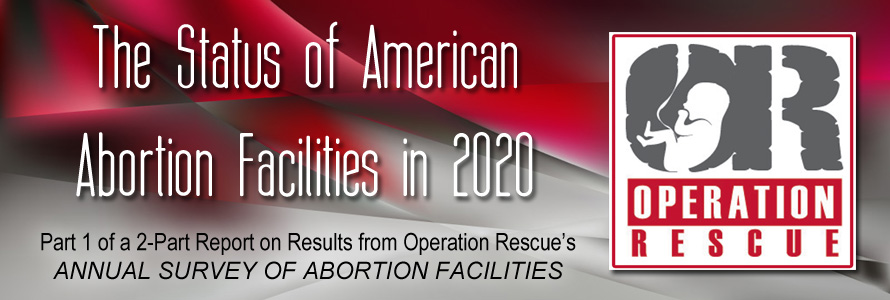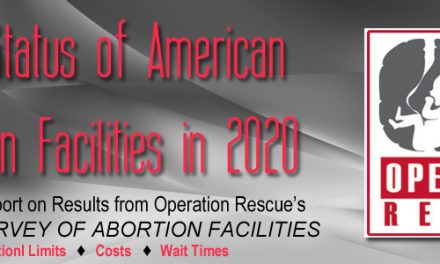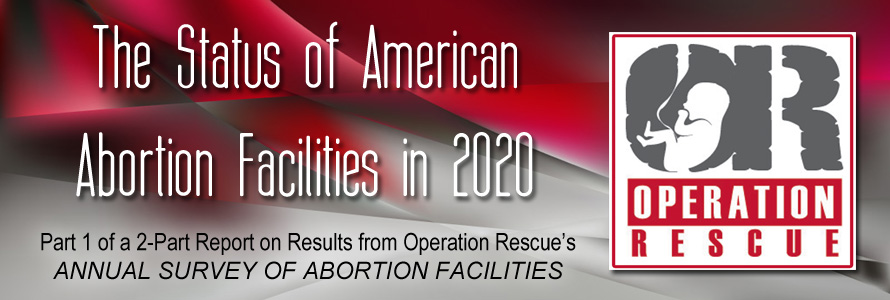
PART ONE OF A TWO-PART OPERATION RESCUE SPECIAL INVESTIGATIVE REPORT
By Cheryl Sullenger
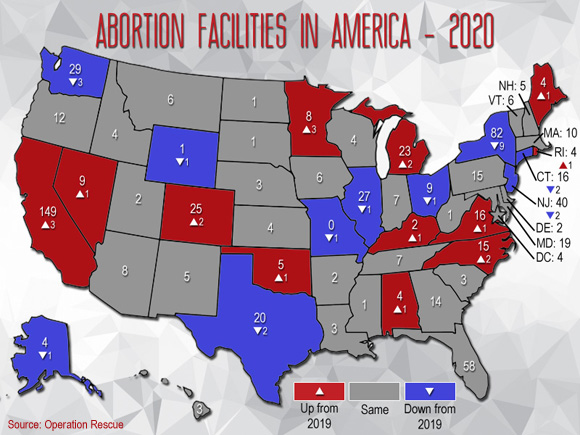
A total of 45 abortion facilities closed or halted abortions nationwide in 2020, leaving one state without an active abortion facility, according to a survey conducted by Operation Rescue.
Missouri has become the first Abortion-Free State – at least in practice for now. The embattled Reproductive Health Services Planned Parenthood in St. Louis was the last abortion facility in Missouri. It remains open, but Operation Rescue has confirmed that no abortion appointments have been available there for months, and none are available anytime in the foreseeable future. All abortion appointments are now being referred to the Fairview Heights Planned Parenthood facility across the Mississippi River in Illinois.
RHS Planned Parenthood won a dramatic licensing battle with Missouri in May after an Administrative Court judge ordered the facility relicensed despite the objections of the Missouri Department of Health and Senior Services, which found the facility to be unsafe and out of compliance with state abortion regulations. The DHSS had documented several cases of life-threatening abortion injuries, but their investigation into those incidents were stone-walled by uncooperative Planned Parenthood employees. Shortly after being relicensed, the facility voluntarily halted surgical abortions in Missouri. It had earlier voluntarily halted the distribution of abortion-inducing pills due to an unwillingness to comply with Missouri laws regulating the drugs. (Read more about this licensing battle at this link.)
“While the RHS Planned Parenthood remains open and licensed for abortions, we confirmed that none are being done there. That means this facility is currently acting only as an abortion referral center. There is no operational abortion facility in the State of Missouri, making it the first Abortion-Free State at this time,” said Operation Rescue President Troy Newman. “It is obvious that Planned Parenthood of the St. Louis Region, which operates RHSPP, seeks to avoid having to comply with Missouri’s strong pro-life laws, and has opted to abort in Illinois where abortion facilities are essentially unaccountable. This shows a gross disrespect for the lives and safety of the women Planned Parenthood purports to serve.”
Other noteworthy facts were revealed by Operation Rescue’s survey of every U.S. abortion facility.
- There are currently 706 active abortion facilities in the U.S.
- Since Operation Rescue began tracking the number of abortion facilities in 2009, surgical abortion facilities have decreased in number by 255.
- Since 1991, there has been an incredible 79 percent drop in the number of surgical abortion facilities nationwide.
- There was a net loss of four U.S. abortion clinics overall in 2020.
- The number of Planned Parenthood abortion facilities decreased in 2020.
- 2020 was the first year that Operation Rescue tracked the number of facilities that distributed abortion drugs via telemedicine. The survey found that 69 locations, representing 9.78 percent of all abortion facilities, now operate telemedicine abortion programs.

Methodology
Each year, Operation Rescue conducts a nationwide survey that involves contact with each abortion business in the U.S. The information gathered about the abortion clinics and their practices represents the most current and accurate data available.
This most recent data was compiled by Operation Rescue from November 16 through December 16, 2020.
Operation Rescue defines “abortion clinics” as those businesses that conduct abortions outside a hospital setting. There are two categories of abortion clinics:
- Surgical Abortion Clinics: These offices conduct surgical abortions. Almost always, surgical facilities also distribute abortion-inducing drugs.
- Abortion Pill Clinics: These offices supply abortions through the administration of drugs (pills) or other chemical means. They do not conduct surgical abortions.
Abortion facility totals
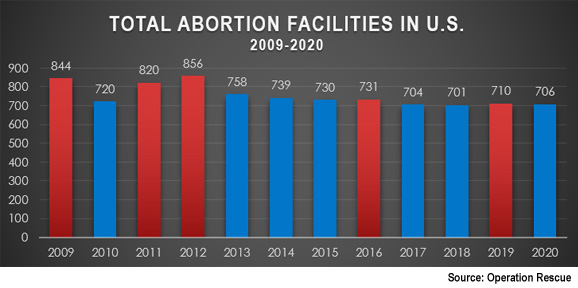
Today, there are a total of 706 U.S. abortion facilities, down a total of four facilities over last year. This marks a return to the downward trend in numbers of abortion facilities nationwide after a slight uptick in 2019 due to an expansion in chemical abortion facilities.
The number of surgical abortion clinics continues to decline with six fewer today than last year at this time.
In fact, the number of surgical abortion clinics has fallen each year for at least the past decade from 713 in 2009 to a record low of 458.
That represents a decrease of 255 surgical facilities — 36 percent – over the past ten years.
“The decline in surgical abortion facilities continues to be bad news for the Abortion Cartel, but is great news for women and their babies,” said Newman. “Surgical abortion facilities are still the most numerous and the most profitable, so when they shut down, it is great news that means lives are being saved.”
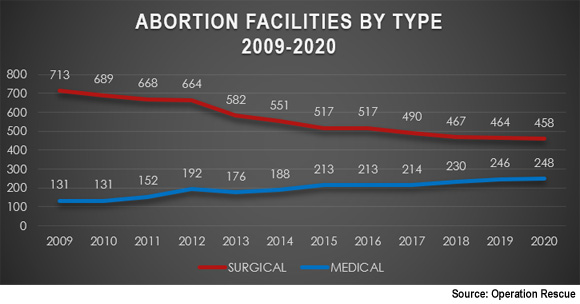
In contrast, abortion pill facility numbers have been steadily on the rise over the past decade, increasing 47.2 percent in the past eleven years.
Today, there are 248 facilities that abort only using chemical means – an increase of only three clinics nationwide in 2020 compared to 15 in 2019. This has slowed Planned Parenthood’s push to expand abortion pill facilities nationwide.
Facilities That Closed or Halted Abortions in 2020
In all, 45 abortion facilities closed or halted abortion services in 2020. Twenty-four of those were surgical facilities, while 21 were abortion pill facilities. This number does not include facilities that temporarily halted abortions, but reopened later in the year.
Interestingly, the largest Democrat states, California and New York, had the most closures or facilities that stopped all abortions. These states were also among the hardest hit with restrictive China Virus lock-downs. There is anecdotal evidence that the restrictions contributed to the inability of some facilities to conduct abortions, but the extent of that impact is unknown at this time.

Of the 45 facilities no longer in the abortion business, at least seven indicated that they hoped to begin offering abortions again at some point in 2021. One facility indicated they could not offer abortions until 2021 at the earliest, because they had no abortionist due to the China Virus. There is a likelihood that at least some of those facilities will never resume abortions.
Some notable facilities that closed or stopped conducting abortions are highlighted below.
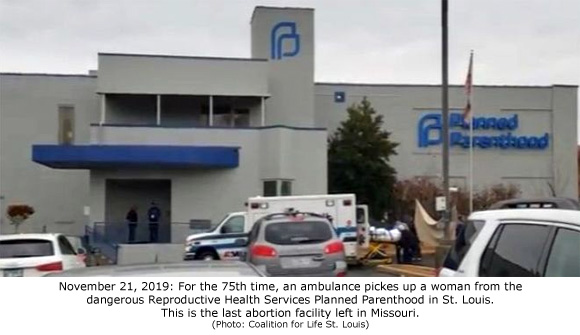
RHS Planned Parenthood, St. Louis, Missouri – As already mentioned, this notoriously dangerous Planned Parenthood facility remains open but has stopped conducting all abortions. With the help of local pro-life activists, Operation Rescue documented 75 medical emergencies that required patient transport directly from RHS Planned Parenthood to hospital emergency rooms – some of which threatened the lives of the women involved.
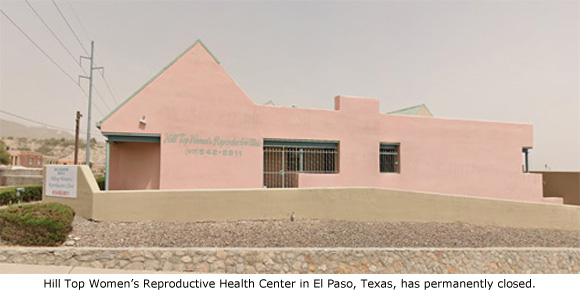
Hilltop Women’s Reproductive Center, El Paso, Texas – This facility, operated by Franz Theard, closed after he and his staff were wracked with the China Virus, which led to the death of his long-time nurse, Gloria Martinez and her husband in November. Theard, who also operates an abortion facility in New Mexico, was sued there on December 22, 2020, for an alleged assault and battery.
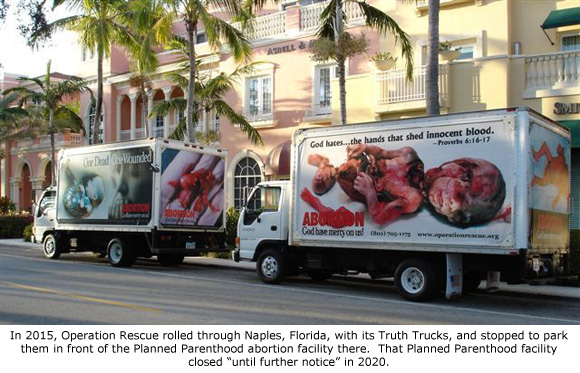
Naples Health Center Planned Parenthood, Naples, Florida – In 2015, Operation Rescue, which once operated a fleet of Truth Trucks, caused a ruckus in the upscale community of Naples, Florida, by parking two of the vehicles at the Planned Parenthood abortion facility. This surgical facility halted abortions in 2020, and is now closed “until further notice.”
States
Since Missouri is now without an active abortion facility, there are five states with only one abortion facility left. Those states are Mississippi, North Dakota, South Dakota, West Virginia, and Wyoming, which saw its only surgical facility close in 2020.

Rhode Island fell off the single-clinic list in 2020 when an independent business, Early Options, opened in Providence in competition with Planned Parenthood.
Of the single-clinic states, four are surgical abortion facilities and the one in Wyoming is an abortion pill facility. South Dakota’s abortion center is the only one operated by Planned Parenthood. The other four are independent abortion businesses.
The total number of abortion facilities increased in ten states over the past year, with California seeing the largest net gain three new facilities.
There was a net decrease in abortion facilities in nine states in 2020, with biggest loss in New York, which dropped nine abortion facilities since 2019.
Thirty-one states and the District of Columbia, had no net change in the number of abortion clinics in the past year. (See map at the top.)
Planned Parenthood
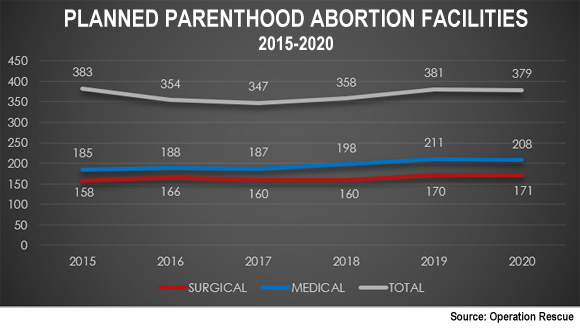
Of the 706 abortion facilities currently open for business, 379, or 52 percent, are Planned Parenthood facilities.
Planned Parenthood’s 171 surgical abortion facilities represent just 37 percent of all surgical abortions facilities. But Planned Parenthood also operates 208 abortion pill facilities – 84 percent of that type of facility currently in operation.
While those statistics seem impressive, in all, Planned Parenthood’s share of the nation’s abortion facilities shrank by two percent in 2020.
While Planned Parenthood operates more facilities than independently owned clinics, it is the independent clinics that still conduct the most abortions, according to a report published in 2020 by the Abortion Care Network.
There are currently six states with no active Planned Parenthood abortion facility. Those states are Louisiana, Missouri, Mississippi, North Dakota, West Virginia, and Wyoming.
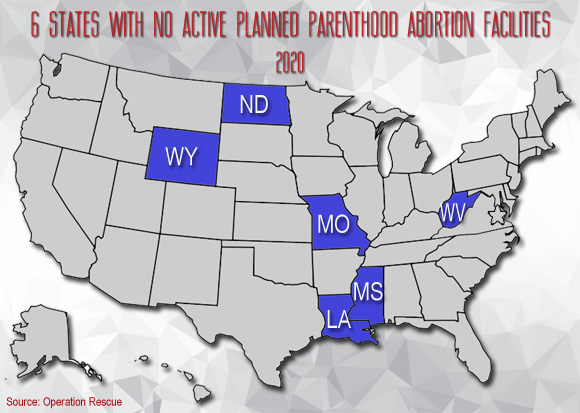
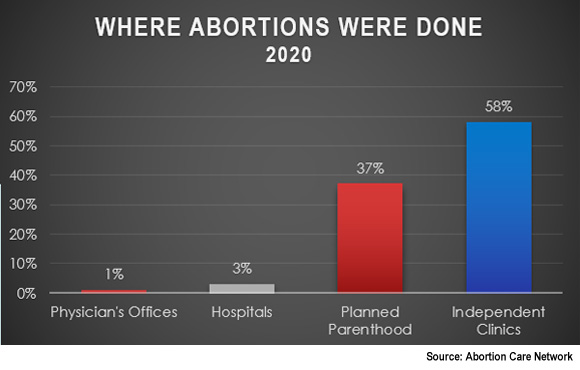
Corona Virus Impact
In 2020, abortion facilities and pro-life activists were forced to contend with new restrictions due to the China virus pandemic. In some Democrat-controlled states, abortion facilities were allowed to remain open while legitimate businesses were ordered to close, churches were shuttered, and people were ordered to stay home.
At first, lines of women were observed that reached out the doors and down the street at several abortion businesses as women rushed to the facilities for panic-driven abortions.
Because of the virus, there was an increased desire to obtain abortions with minimal personal contact. This led to an expansion of telemedicine programs that were used to dispense abortion pills to women.
While telemedicine programs were restricted to a handful of abortion facilities prior to the pandemic, in 2020, Operation Rescue documented 69 facilities that now use telemedicine to dispense abortion-inducing drugs.
However, that expansion was limited to existing facilities, for the most part. In fact, facilities that added telemedicine abortions had minimal effect of the number of abortion facilities nationwide. In fact, there has only been an increase of two in abortion pill “facilities” nationwide over 2019.
Those two new abortion businesses – Just the Pill, based in Minnesota, and Choix in California –operate exclusively over the internet and have no physical address and distribute abortion drugs to women solely through the U.S. Mail. They can only prescribe to women who reside within the business’ home states.
Due to the China Virus, the U.S. Food and Drug Administration relaxed a 2000 law that required women to visit a clinic, doctor’s office, or hospital before they could receive the two-drug abortion cocktail. Just the Pill and Choix operate as they do only because of the temporary lifting of that law.
The Trump Administration has sought to have that law reinstated, and filed an appeal to the U.S. Supreme Court on December 15, 2020. If the High Court rules in favor of reinstatement, it would likely put the internet/mail pill distributors out of business, unless they change their practices.
However, should the Democrats resume control of the White House, it is possible that the FDA restriction will never be reinstated. Operation Rescue predicts that would allow the internet sale of abortion drugs and distribution through the U.S. Mail to increase exponentially in 2021.
Yet, there are still eighteen states that completely ban the use of telemedicine to distribute abortion drugs. Those state laws have so far hindered the widespread expansion of telemedicine abortion businesses, and should continue to do so.
Political influences
Pro-life legislative advances have traditionally been much more numerous and effective at the state level than the Federal level, and 2020 was no different.
Six states enacted 17 life-affirming laws that added protections to women and their unborn babies, strengthened parental rights, and added new protections for minors from abuse. Those states were Florida, Idaho, Indiana, Iowa, Kentucky, and Louisiana.
Pro-abortion legislation that expanded abortion was enacted only in Virginia and the District of Columbia
It usually takes time for legislation passed on the state level to have an impact, especially if the enactment of new laws are delayed by challenges in court, as is the case with most pro-life legislation.
Nevertheless, pro-life legislation passed in previous years continues to contribute to clinic closures, as was seen this year in Missouri, and is providing necessary road-blocks to keep the rapid expansion of abortion chains in check nationwide.
On the Federal level, President Donald J. Trump, handed pro-life supporters several victories through rules changes, policy decisions, and Executive Orders.

His 2019 Protect Life Rule took effect in 2020, denying Planned Parenthood approximately $60 million in tax-payer funds. This led to the closure of several Planned Parenthood facilities nationwide.
However, the impact has been less than some predicted. This is because several Democrat-controlled states replaced the lost federal funding with state tax dollars. Monitoring of news reports has showed reason to believe that private donations to Planned Parenthood also increased to compensate.
President Trump made the decision in mid-December withhold $200 million from the State of California because it requires all health insurance policies to include abortion coverage. The impact of that decision won’t be felt until 2021.
But perhaps President Trump’s most potentially impactful pro-life acts in 2020 were his appointments of Federal judges that have transformed the judiciary. Since his term began, he has appointed over 300 new conservative Federal judges. This gives pro-life legislation that is known to affect the ability of some abortion facilities to operate a better chance of surviving future Constitutional challenges.
Also this year, President Trump nominated Amy Coney Barrett, the first openly pro-life Justice to the U.S. Supreme Court – his third pick for the High Court since he took office. This has created the first conservative majority on the Supreme Court in decades and paved the way for Roe v. Wade to be reversed at some future time.
Currently 10 states have trigger laws that would immediately ban abortion should Roe be overturned. Those are Arkansas, Idaho, Kentucky, Louisiana, Mississippi, North Dakota, Missouri, Tennessee, South Dakota, and Utah.
The impact of Trump’s judicial appointments and other pro-life policies are sure to be felt for years to come.
Factors Contributing to Fewer Abortion Facilities
The decrease in the number of abortion facilities in 2020 is attributable to at least three factors.
- State laws.
- Regulatory issues.
- The China Virus.
In past years, a decrease in demand for abortions played a role in clinic closures, however, what effect the China Virus has had on abortion demand remains unknown for now, until state abortion numbers for 2020 are released.
Also in past years, the retirement of abortionists played a role in abortion facility closures. While at least one facility in California closed due to abortionist retirement, that trend is fading due to the rapid training of new abortionists through programs affiliated with the Bixby Center for Global Reproductive Health. That organization claims to have trained 7,100 abortionists world wide from 1999 through 2018.
In 2020, Operation Rescue published an exposé about Bixby’s U.S. abortion training programs, their funding, and their globalist depopulation goals. (Read that exclusive report.)
Conclusions
Since 2020 has been a troubled and unpredictable year, there has been a bit of a shake-up in some abortion industry trends, there has been stability in others. For example, surgical abortion facilities continue to dominate at 65% of all abortion facilities. That percentage is unchanged from 2019, and down just two percent since 2018.
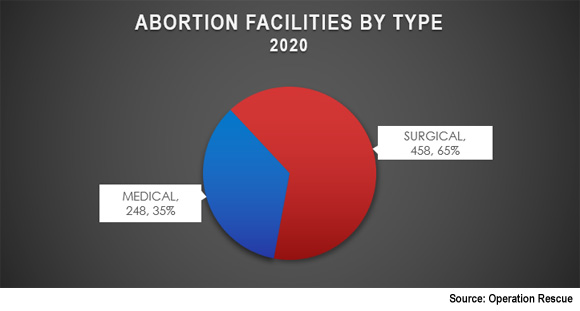
Operation Rescue’s survey also found that most abortion pill facilities continue the previously documented trend of being comprised primarily of part-time facilities, whereas surgical facilities tend to have more abortion days available. The survey found that some abortion pill clinics are only open to dispense abortion drugs as infrequently as once a month.
There is no doubt that the China Virus was responsible for a new trend toward expanded telemedicine programs that distributed abortion drugs with minimal contact. However, this expansion did not lead to any substantial increase in the number of abortion facilities nationwide.
The increase in abortion pill distribution through the U.S. mail was also noted in 2020. This trend was predicted by Operation Rescue in an exposé published in May 2019. While we considered this a back-up plan to be implemented should Roe v. Wade be overturned, the China Virus accelerated that timeline, with the aid of the FDA’s decision to “temporarily” relax distribution guidelines. Whether this trend continues to hold after the China Virus subsides remains to be seen.
“Overall, we are grateful for fewer active abortion facilities in 2020 and for the 45 clinics that closed or halted abortions. With all the turmoil in our nation, 2020 could have been much worse for the unborn,” said Newman.
Current events will undoubtedly play a part in future abortion trends.
“I predict that 2021 will be a crossroads of sorts for the Abortion Cartel and the Pro-Life Movement alike,” said Newman. “National politics could have a greater impact than ever this year. If the Republicans maintain control of the Executive Branch, we could see huge pro-life gains. If the Democrats assume power over the Executive Branch, we could see an abortion expansion not witnessed since the early years after the Roe v. Wade decision decriminalized abortion nationwide. So much remains in limbo at this moment. But whatever challenges 2021 holds, Operation Rescue will continue to work toward our goal of building an Abortion-Free America and a bright future of the children of tomorrow.”
Up next: The Status of American Abortion Facilities in 2020, Part 2, which will reveal trends in abortion costs, wait times, gestational age limits, and more.

